How I Use Google Drive For University - Pt 1: Digital Notetaking By Kkaitstudies

how i use google drive for university - pt 1: digital notetaking by kkaitstudies
idk about you but i’ve tested a bunch of note taking methods. in my last few years of university, i was indeed lazy and rarely referred back to the professor’s slides in the course shell. i opted to read off the slides in lecture and take notes. while MS OneNote is great, i found myself enjoying Google Drive much more. so here is a quick overview of how i take notes using Google Docs.
folders are your friends
make separate folders for each of your courses. google drive even gives you the option to change the colours of the folders. in these folders, add any relevant coursework such as the syllabi, readings, and your notes document.

use one doc for notes per course
once you receive the syllabi, take some time to take note of required readings, and assignment deadlines. i have created a free template you can save to your own google drive that you can access here. fill out:
- course code & name - prof’s name, office hours, and email - date(s) for each week of class - weekly readings (tip: if you have online readings, you can link them in the doc!) - & open the document outline (view > show document outline)
you also don’t have to use all these features. T B H, i didn’t do weekly readings. a lot. oops. BUT i did always pay attention in lecture. i simply deleted the “reading notes” header every week i didn’t bother to read.

make use of early access to lecture slides, headers, etc.
some profs (bless their souls) post the slides sometime before the lecture. if you have the time, copy the lecture slides into your notes. and if they don’t…type real quick to get all the info as it’s happening (or go back to slides online after lecture to see what you missed out on). i separate lecture topics with headers, with the bullet points underneath (see above). if there is anything that the prof says during class that isn’t in the lecture slides, i will change the colour of the text to a different colour. any important concepts or testable material are highlighted.
…and that’s how i take notes! everyone is different. not all note-taking methods work for everyone. this is what worked for me in my last 2 years of uni. hopefully a similar structure works for some of y’all! also, let me know what you think and @ me if you end up using my template. have a great semester!
coming soon: [ part 2: grade tracker | part 3: gmail and gcal ]
More Posts from Stubbytime and Others
i feel completely and totally normal about this. nothing irrational happening in my brain.
14 seconds of oscar and logan being adorable buffoons

letrice__
My Changing Skies Predictions : D
Leafstar going blind will be treated as a fate worse than death.
Squirrelstar will be constantly mocked by the narrative and characters alike. Thunderclan will lament that Bramblestar was a much better leader.
While making reasonable decisions, Skyclan treats Leafstar like Squirrelflight was treated as interim leader during TBC.
Moonpaw is a Nightsun baby. She'll get along with and admire Nightheart, but resent and have a difficult relationship with Sunbeam.
Events from past arcs will be brought up in an attempt by the Erin Hunter Collective to show that they totally know their stuff. All of these callbacks will be entirely superficial.
Tigerheartstar's characterisation will change on a whim.
Windclan won't get to do anything. Whistlepaw is mentioned exactly once.
At some point the narrative makes it clear that the writers think Tawnypelt joined Shadowclan after Tigerstar died.
At least one of the three POV characters has barely any plot material. Despite this, they still get equal screen time with the other two characters.
Moonpaw is a medicine cat apprentice. She struggles with horrific things happening to her constantly, and a connection she once thought was to Starclan turns out to be to something much darker. She ends up ostracised because everyone around her doesn't believe her for arbritary reasons.
Starclan do terrible things. One of the morals of the arc is that Starclan is still the most important part of Clan life.
The only thing that is destroyed by Twolegs is the Moonpool. They find a new one (with Tawnypelt or Leafstar sacrificing their lives so it can be found). This restores the status quo.
One of the Erin Hunters declares that they believe wholeheartedly in Starclan and have decided to found the first IRL Moonstone.
lando and oscar designing their own grandstand seats!

ferrari and her devoted predestined

the original painting is by Alméry Lobel-Riche, but the colors/lighting idea came entirely from the lovely @/cuarto_sol on twt
Two job-hunting resources that changed my life:
This cover letter post on askamanger.com. A job interview guide written by Alison Green, who runs askamanager.
Can a centaur bend down at the waist to pick something up the same way a horse can lower its head? Or do they have to do an awkward stance to reach whatever they dropped?

Oh absolutely! I mean, I think it would depend on the flexibility of the centaur, much like touching your toes - if you haven't trained and stretched for a bit of flexibility they would likely have to bend a knee to get down there.

Embroidery 101

Introduction:
Embroidery is a craft that uses thread to decorate fabric (and other materials). It's a great way to spruce up a garment, customise objects, and to hide mends you've made!
Embroidery is usually done with embroidery floss, but depending on the base material you're working on, you could also use yarn, ribbons, or plain old sewing thread. Don't be afraid to experiment!
Embroidery is easier to do on taut fabric than limp fabric. That's why most people use embroidery hoops. While not strictly necessary, a hoop will make your life so much easier.
Using the right needle will help, too. Use a crewel needle if you're working with embroidery floss, a chenille needle if you're working with ribbon or yarn, or a tapestry needle if you're doing cross-stitch embroidery on open-weave fabrics.
While there are many types of embroidery from all over the world, this post will focus on some basic stitches you can use in your own work.
Basic embroidery stitches:
For a more thorough overview of embroidery stitches, check out these embroidery tutorials by Mary Corbet's Needle 'n Thread.
The following images show some of the most basic stitches:

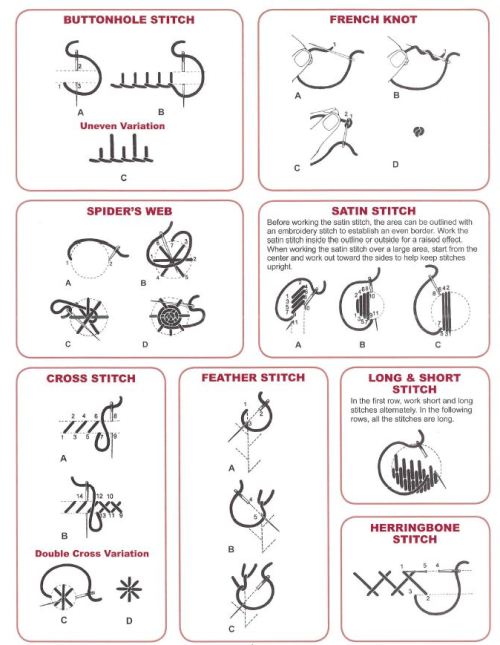
(Image source)
The 16 stitches in the images above can be combined into any shape or form you want. You might recognise some from my hand sewing post: embroidery is a type of hand sewing, after all.
You don't need to know all of these to be able to make beautiful things. Even just one of these is a great start for a project.
This sampler by Sew Nancy shows how these basic stitches can be used to outline shapes or form flowers, for example.
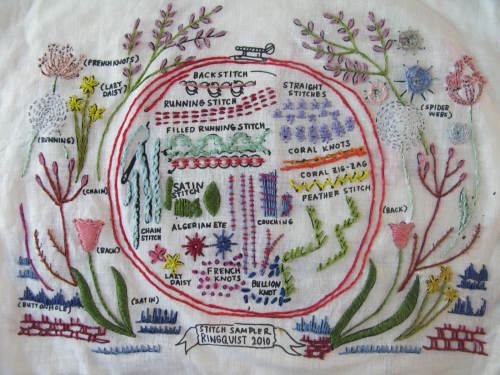
(Image source)
Fiorelila used a combination of the stem stitch, satin stitch, lazy daisy, and french knots to spruce up this sweater:
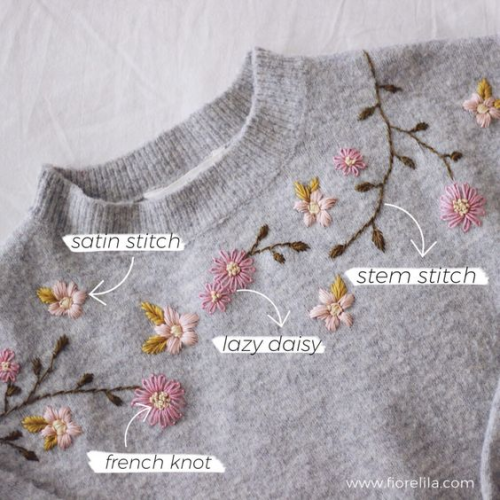
(Image source)
And this person used lazy daisies to add some flair to their jeans:
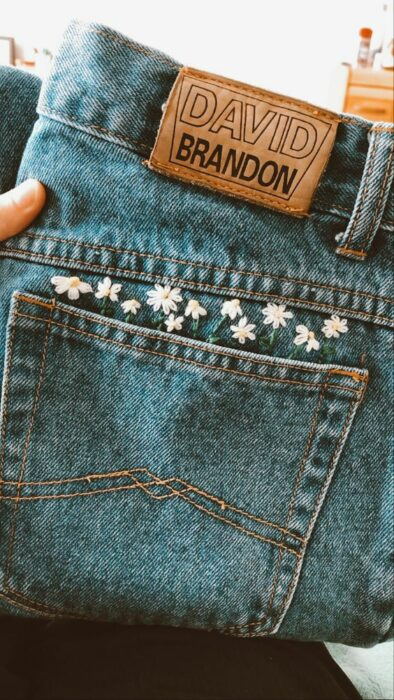
(Image source)
Embroidery for visible mending:
Embroidery is a useful tool to hide mends you've made, or to even accentuate them if that's your style. This is called visible mending. While this is a topic that deserves a post on its own, here are some quick examples:
Like this fix by Redditor Takemythyme who embroidered a rose over a hole in a knit fabric:

(Image source)
Or like how this person has spruced up their jeans repairs with embroidery:
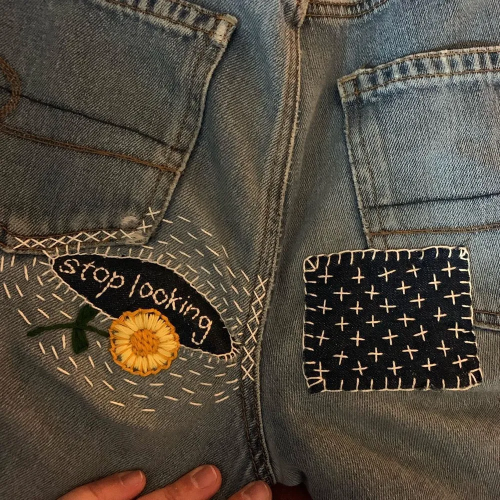
(Image source)
In this example, The Woolery Guy chose to use flower embroidery to make a hole in a knit fabric look like it was there by design:

(Image source)
For more examples, check out Pinterest or VisibleMending.com.
Conclusion:
Embroidery is a useful skill to give new life to your wardrobe. You can use it to give some flair to items you've grown bored off, or even to mend your clothes.
Once you've got a few basic stitches under your belt, the possibilities are endless. Be creative and have fun with it!
Good luck and feel free to show me your work!
-
 slytherinscript reblogged this · 2 weeks ago
slytherinscript reblogged this · 2 weeks ago -
 neogotmypack liked this · 2 weeks ago
neogotmypack liked this · 2 weeks ago -
 roxypearl1 liked this · 2 months ago
roxypearl1 liked this · 2 months ago -
 coffeeandsnark reblogged this · 5 months ago
coffeeandsnark reblogged this · 5 months ago -
 annav8lx4 liked this · 5 months ago
annav8lx4 liked this · 5 months ago -
 sirentsuki liked this · 1 year ago
sirentsuki liked this · 1 year ago -
 benschiff reblogged this · 1 year ago
benschiff reblogged this · 1 year ago -
 uhleesuhsimports reblogged this · 1 year ago
uhleesuhsimports reblogged this · 1 year ago -
 insertmoviereference liked this · 1 year ago
insertmoviereference liked this · 1 year ago -
 bolsdersforthcaha liked this · 1 year ago
bolsdersforthcaha liked this · 1 year ago -
 fabfabfa-fab reblogged this · 1 year ago
fabfabfa-fab reblogged this · 1 year ago -
 hydrangeahelper reblogged this · 1 year ago
hydrangeahelper reblogged this · 1 year ago -
 unsuccessfullyknown liked this · 1 year ago
unsuccessfullyknown liked this · 1 year ago -
 trstmeimaliar liked this · 1 year ago
trstmeimaliar liked this · 1 year ago -
 languagesandstuff reblogged this · 1 year ago
languagesandstuff reblogged this · 1 year ago -
 tenzpm reblogged this · 1 year ago
tenzpm reblogged this · 1 year ago -
 studyingfeminism liked this · 2 years ago
studyingfeminism liked this · 2 years ago -
 sislearning liked this · 2 years ago
sislearning liked this · 2 years ago -
 imagineadi reblogged this · 2 years ago
imagineadi reblogged this · 2 years ago -
 indefinitereferences reblogged this · 2 years ago
indefinitereferences reblogged this · 2 years ago -
 coffeeandsnark reblogged this · 2 years ago
coffeeandsnark reblogged this · 2 years ago -
 rkiveofstudies reblogged this · 2 years ago
rkiveofstudies reblogged this · 2 years ago -
 niviferweeps liked this · 2 years ago
niviferweeps liked this · 2 years ago
